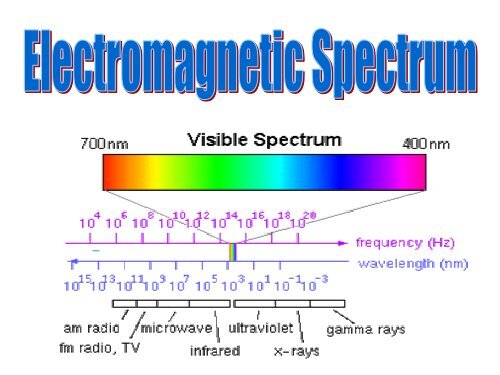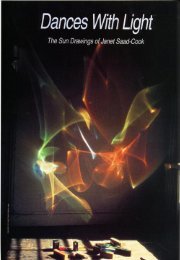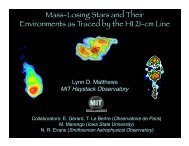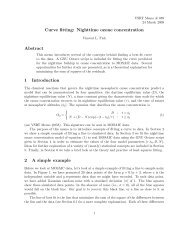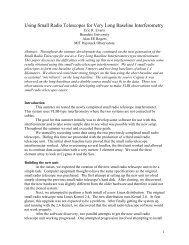Electromagnetic Spectrum - MIT Haystack Observatory
Electromagnetic Spectrum - MIT Haystack Observatory
Electromagnetic Spectrum - MIT Haystack Observatory
You also want an ePaper? Increase the reach of your titles
YUMPU automatically turns print PDFs into web optimized ePapers that Google loves.
Radiation<br />
-Transfer of energy through empty space in<br />
the form of waves
Wavelength (λ)<br />
- the distance from crest to crest, or trough to trough<br />
- measured in meters
Amplitude<br />
- maximum departure from an undisturbed state
Wave Period<br />
- time it takes 2 crests (or troughs) to travel past the<br />
same point in space<br />
Frequency<br />
- number of waves passing a given point<br />
per unit of time<br />
Wave frequency =<br />
1<br />
_______________<br />
Wave Period<br />
A period of 2 seconds = a frequency ½ wave per second<br />
Frequency units are Hertz (Hz) which are the number of cycles per second
Comparison of wave properties
Wave Traveling through Space<br />
The small circle shows the amplitude of the wave as it goes by us<br />
The frequency of oscillation of the dot is the frequency of the wave.<br />
http://www.upscale.utoronto.ca/GeneralInterest/Harrison/Spectra/Spectra.html
Waves are formed as a result of a disturbance of<br />
electrically charged particles…. electrons and protons<br />
Disturbances from heating or collision, for example can<br />
create vibrations which send radiation waves<br />
through space
- Moving electric charges create magnetic fields.<br />
-Hence every changing electric field has a corresponding<br />
magnetic field.<br />
-So all accelerating charges create changing electric and<br />
magnetic fields.
<strong>Electromagnetic</strong> Radiation<br />
is carried in the form of fluctuating electric and<br />
magnetic fields which are perpendicular to each<br />
other.
- Range of electromagnetic<br />
radiation from radio<br />
waves to gamma rays<br />
- Each type is defined<br />
by the specific<br />
wavelength and frequency<br />
- All travel at the same speed…<br />
the speed of light<br />
(186,00 miles/sec or 300,000 km/sec)<br />
- Wavelength x frequency= velocity
Size of <strong>Electromagnetic</strong> <strong>Spectrum</strong> of Radiation
<strong>Spectrum</strong> of <strong>Electromagnetic</strong> Radiation<br />
Region<br />
Wavelength<br />
(Angstroms)<br />
Wavelength<br />
(centimeters)<br />
Frequency<br />
(Hz)<br />
Energy<br />
(eV)<br />
Radio > 10 9 > 10 < 3 x 10 9 < 10 -5<br />
Microwave 10 9 -10 6 10 - 0.01 3 x 10 9 -3 x 10 12 10 -5 -0.01<br />
Infrared 10 6 - 7000 0.01 - 7 x 10 -5 3 x 10 12 - 4.3 x 10 14 0.01 - 2<br />
Visible 7000 - 4000 7 x 10 -5 -4 x 10 -5 4.3 x 10 14 -7.5 x 10 14 2 - 3<br />
Ultraviolet 4000 - 10 4 x 10 -5 -10 -7 7.5 x 10 14 -3 x 10 17 3 - 10 3<br />
X-Rays 10 - 0.1 10 -7 -10 -9 3 x 10 17 -3 x 10 19 10 3 -10 5<br />
Gamma Rays < 0.1 < 10 -9 > 3 x 10 19 > 10 5
Wavelength Units<br />
Nanometer (nm) preferred<br />
10 9 nanometers in 1 meter<br />
Angstrom 1 Å = 10 -10 m = 0.1 nm<br />
Visible Light <strong>Spectrum</strong><br />
400-700 nm or 4000 to 7000 Å<br />
-Our eyes are most sensitive to the<br />
middle range 550 nm (yellow –green)_<br />
-Sun emits most of its electromagnetic<br />
energy within this range<br />
Radio Waves<br />
- Range in size from .001 meters to thousands of meters
Radio waves and visible<br />
light are the only wavelengths<br />
transparent to the<br />
atmosphere, so observations<br />
can be made from the Earth’s<br />
surface in these wavelengths<br />
A part of the infrared spectrum<br />
is visible from earth.<br />
A very small amount of<br />
Ultraviolet rays reach the Earth<br />
and can give you a sunburn.<br />
Gamma rays, x-rays, and<br />
ultraviolet radiation must be<br />
recorded by satellites above<br />
the Earth’s atmosphere.
Atmosphere window of electromagnetic radiation
Black Body <strong>Spectrum</strong><br />
- All macroscopic objects (above absolute zero) emit radiation.<br />
You, fire, ice, stars, the floor all emit radiation all the time.<br />
-Electrons in atoms are constantly in random motion, and whenever<br />
charged particles change their motion electromagnetic radiation<br />
is emitted.<br />
Temperature is a direct measure of the amount of microscopic<br />
movement.<br />
- The greater the movement the hotter the temperature<br />
-The most important property use to identify the<br />
type of radiation emitted is Temperature.
Intensity (Brightness) of Radiation<br />
- amount and strength of radiation at any given point in space<br />
-spread over a range of frequencies across the electromagnetic<br />
spectrum<br />
Blackbody<br />
- theoretical object that is a perfect absorber and emitter of radiation<br />
-Blackbody (or Planck) curve shows the distribution of intensity of the<br />
radiation emitted by an object
Blackbody<br />
- As temperature increases there is a shift toward higher<br />
frequencies (shorter wavelengths) and greater intensities.
Again, you can see that as an object’s temperature increases,<br />
the frequency and intensity of emitted radiation also increase.
Peak Emissions for different objects
By measuring the wavelength at the peak of a star’s spectrum,<br />
We can calculate the surface temperature of the star.
Wien’s Law<br />
- Wavelength of peak emission is a function of temperature<br />
-The hotter objects emit most<br />
of their radiation at<br />
shorter (bluer) wavelengths<br />
-The cooler objects emit<br />
most of their radiation at<br />
longer (redder) wavelengths
Wien’s Law<br />
(Peak Wavelength) λ = 0.29 cm/T o K<br />
Examples<br />
1. Your body emits radiation at 300 o K. What would the size and<br />
type of your emitting wavelength be?<br />
λ = .29cm/300<br />
λ = .001 cm<br />
infrared radiation<br />
2. What is the surface temperature of the sun if its peak<br />
wavelength is 500 nm ?<br />
500 nm = .29 cm/T o K<br />
.29/.00005 = 5800 o K
Stefan-Boltzmann Law<br />
-As an object’s temperature increases, the total energy it radiates<br />
(over all the frequencies) increases by a power of four.<br />
Total energy radiated is proportional to temperature 4<br />
Example<br />
- Doubling the temperature will cause the total energy radiated<br />
To increase by a factor of 16.
Look at the peak wavelength<br />
emissions for the following<br />
four stellar objects.<br />
What type of peak wavelength<br />
do they each have?<br />
(a.) Radio<br />
(b.) Infrared<br />
(c.) visible<br />
(d.) ultraviolet
Spectral Lines<br />
Spectroscope<br />
- instrument used to analyze visible light
3 Types of Spectra<br />
- Continuous, Emission and Absorption Spectra
3 Types of Spectra
Continuous <strong>Spectrum</strong><br />
- <strong>Spectrum</strong> is continuous over all the frequencies of visible light
Emission <strong>Spectrum</strong><br />
- Bright line spectrum which is discontinuous<br />
- Low density hot gases emit the bright lines.<br />
-Emission Lines are characteristic of the particular atoms<br />
(in the gas) emitting the photons, indicating the chemical<br />
composition of the gas
Absorption Lines<br />
- Low density cool gas absorbs certain wavelengths of the continuous<br />
spectrum and leaves dark lines.<br />
- These lines are exactly at the same wavelength as emission spectrum,<br />
which are produced by that gas (atoms in that gas) at a higher<br />
temperature
Example of the Sun’s <strong>Spectrum</strong>
Radio Waves<br />
-Radio waves viewed on Earth from space have a much larger<br />
window on the electromagnetic spectrum<br />
-Although you can’t “see” radio waves, you see them in use everyday.<br />
- Can you brain storm a list of radio waves used around you<br />
AM and FM radio broadcasts<br />
Cordless phones<br />
Garage door opener<br />
Wireless networks<br />
Radio controlled toys<br />
TV broadcasts<br />
GPS receivers<br />
Ham radios<br />
Police radios<br />
Wireless clocks<br />
Satellite communications<br />
Baby monitors<br />
Microwave ovens<br />
Radar<br />
Scanners
How can all these things use radio waves and not overlap?<br />
- They all run on different frequencies.<br />
- There are thousands of different radio waves.<br />
-The FCC (Federal Communications Commission) decides who<br />
uses what frequency<br />
<strong>Spectrum</strong> of Radio Waves
Basic radio wave technology<br />
- Waves are sent by a transmitter and received by a receiver<br />
Both use antennae to radiate and to capture
AM radio stations frequencies are kHz (thousands of cycles per second)<br />
FM radio stations frequencies are MHz (millions of cycles per second)<br />
AM radio waves use amplitude<br />
modulation to sent data<br />
FM radio waves use frequency<br />
modulation to sent data
Radio Astronomy<br />
- The transmitters in radio astronomy are stellar and interstellar objects<br />
- The receivers are placed at the focus of the reflecting parabolic dish
Radio Waves in Space<br />
-Radio waves are used for looking at long wavelength and low<br />
temperature sources<br />
Examples:<br />
-Center of the Milky Way is a radio source<br />
-Background radiation from the Big Bang<br />
-Pulsars<br />
-Mapping the rotation of the Milky Way Galaxy<br />
-Expansion of the Universe (red shifting)<br />
-Pinpoint CO emissions which show molecular clouds (birth places of stars)<br />
-SETI uses radio to look for intelligent signals
Comparative view of radio and visible images of the galaxy<br />
Radio Wave view of the Milky Way<br />
Visible light view of the Milky Way


